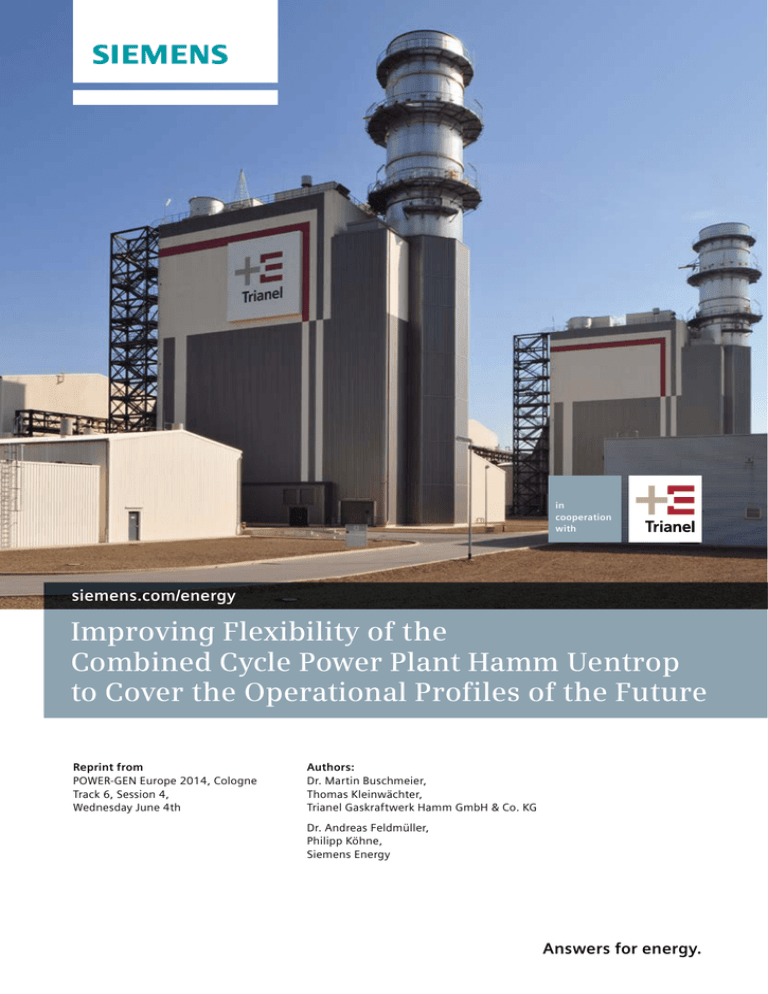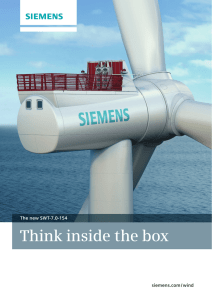
in
cooperation
with
siemens.com/energy
Improving Flexibility of the
Combined Cycle Power Plant Hamm Uentrop
to Cover the Operational Profiles of the Future
Reprint from
POWER-GEN Europe 2014, Cologne
Track 6, Session 4,
Wednesday June 4th
Authors:
Dr. Martin Buschmeier,
Thomas Kleinwächter,
Trianel Gaskraftwerk Hamm GmbH & Co. KG
Dr. Andreas Feldmüller,
Philipp Köhne,
Siemens Energy
Answers for energy.
Introduction
The global energy markets are rapidly changing due to increasing renewable power generation
and decreasing power prices in the electricity markets in many countries.
This leads to new operating profiles with higher flexibility requirements for many fossil power
plants. Combined cycle power plants originally designed for base or intermediate load may
require improved start-up performance, extended capabilities for ancillary services, or minimized
part loads.
As investment plans for new and flexible power plants are not progressing in line with demand
in most European countries, it is of utmost importance to adjust the capabilities of the legacy
fleet to future flexibility needs. Flex-Power ServicesTM is an activity of Siemens Energy Service
which targets all aspects of plant operation with an integrated approach (Figure 1).
Figure 1: Aspects of Siemens Flex-Power ServicesTM
The investment available for these upgrades and modernizations may be limited due to
depressed power prices and their consequences for plant economics. Nevertheless, given close
cooperation between plant operator and plant equipment supplier, improved plant performance
is often feasible and operational flexibility may be enhanced without excessive changes to
components.
This paper presents recent operational enhancements and the ongoing cooperation between
Trianel and Siemens to adapt the operational performance of the combined cycle power plant
Hamm Uentrop in Germany.
Trianel Gaskraftwerk Hamm GmbH & Siemens Energy: “Improving Flexibility of the
Combined Cycle Power Plant Hamm Uentrop to Cover the Operational Profiles of the Future”
2
POWER-GEN Europe 2014, Cologne
The Trianel combined cycle power plant Hamm Uentrop, Germany, in a changing market
environment
Trianel, a large communal network of 56 shareholders as shown in Figure 2, decided in 2005 to
order a combined cycle plant and Siemens was chosen to supply two turnkey single shaft
configurations.
Figure 2: The Trianel communal network, February 2014
Both units of the plant Hamm Uentrop had first fire in 2007. Details of the plant, including the
gas turbines SGT5-4000F, the steam turbines SST5-3000 and the generators SGen5-2000H
are shown in Figure 3 and Figure 4.
Trianel Gaskraftwerk Hamm GmbH & Siemens Energy: “Improving Flexibility of the
Combined Cycle Power Plant Hamm Uentrop to Cover the Operational Profiles of the Future”
POWER-GEN Europe 2014, Cologne
3
Figure 3: Trianel Combined Cycle Power Plant Hamm Uentrop, Germany
Figure 4: Trianel Combined Cycle Power Plant Hamm Uentrop, key data
Trianel Gaskraftwerk Hamm GmbH & Siemens Energy: “Improving Flexibility of the
Combined Cycle Power Plant Hamm Uentrop to Cover the Operational Profiles of the Future”
4
POWER-GEN Europe 2014, Cologne
The plant was designed for up to 8000 operating hours per year. In 2013 Hamm Uentrop
contributed with approximately 4250 full load hours and more than 5200 operating hours per
unit to German power generation, despite the challenging market conditions described in Figure
5 and discussed in more detail by Sven Becker in [1].
Figure 5: Issues and Challenges of the German „Energiewende“
This relatively high number of operating hours was possible thanks to a long-term gas contract
at reasonable prices and to the ability to provide the market with ancillary services such as
secondary frequency response and minute reserve (tertiary frequency response). In addition to
the technical capabilities required for offering flexible operation to the transmission system
operator, highly professional energy production planning is a must for the best possible plant
economics. The Hamm Uentrop plant is managed by Trianel utilizing specialized software
based on stochastic optimization algorithms that helped to improve the profit margin, as can be
seen in [2].
Trianel Gaskraftwerk Hamm GmbH & Siemens Energy: “Improving Flexibility of the
Combined Cycle Power Plant Hamm Uentrop to Cover the Operational Profiles of the Future”
POWER-GEN Europe 2014, Cologne
5
Extended requirements for flexible plant operation
The consequences of current market conditions for plant operation are in general:
• Low profit margin
• Frequent part load operation
Reduced efficiency
Increased emissions
• Fluctuating prices on the power trading exchange
Frequent adjustments to the operation schedule (in 15 minute slots)
Control of the plant to match grid requirements
• Increasing number of redispatch requests due to instability of the grid
Changes to the operating schedule
Delayed start-up times
Forced night-time operation
• Minute reserve and secondary frequency support
High load change requests for short duration (15 minutes) and at short notice
This leads to tougher requirements for operational flexibility in terms of fast transients and
frequent part-load operation. The typical generation pattern is no longer dominated by constant
load, and continuous operation at maximum power has been replaced by constant trading
activity, changing output in 15 minute slots and/or delivering secondary or tertiary frequency
response to stabilize the grid. Severe operating patterns as shown in Figure 6 are becoming
more and more common in the business.
Declining power prices have made especially the contribution of secondary frequency response
more important to plant economics.
In 2011 Trianel requested the original equipment manufacturer Siemens to develop and offer
solutions that could help it to stay in the market longer or return earlier!
In combined cycle power plants, the gas turbine plays a major role in the overall performance of
the plant, so that Siemens' immediate response was to accelerate its development activities to
steepen the gas turbine load gradient from 13 MW/min to higher values [3,4]. Nevertheless the
potential for improving the operational flexibility of a combined cycle plant is very much
dependent on integrated solutions that take all components of the plant into account, especially
the interaction of the gas turbine with the downstream steam cycle.
Trianel Gaskraftwerk Hamm GmbH & Siemens Energy: “Improving Flexibility of the
Combined Cycle Power Plant Hamm Uentrop to Cover the Operational Profiles of the Future”
6
POWER-GEN Europe 2014, Cologne
Figure 6: Operating pattern with high and frequent load changes
Stepwise improvements in the secondary frequency response capabilities of the plant
The request to improve the plant's secondary frequency response capabilities and the
subsequent meetings between Trianel and Siemens culminated in a first step: the unit control
system was modified to make allowance for a possible contribution by the steam cycle. The
prequalification test in April 2013 validated 69 MW in five minutes, an improvement of 9 MW
compared to the 60 MW in five minutes which Trianel was used to bringing to the market.
Implementation of this “Combined Cycle Load Gradient” was the first time ever in a single-shaft
configuration, with the added difficulty that only the sum of gas turbine and steam turbine output
can be measured at the generator.
In a second, bigger step, a 26 MW/min gas turbine load gradient was implemented and
prequalified in August 2013, totaling a change of 135 MW in 5 minutes, equivalent to an
average of 27 MW/min combined cycle net output gradient, see Figure 7. This result was
achieved by utilizing the gas turbine and the additional steam turbine power which sets in with a
certain time lag within the 5 minutes.
Trianel Gaskraftwerk Hamm GmbH & Siemens Energy: “Improving Flexibility of the
Combined Cycle Power Plant Hamm Uentrop to Cover the Operational Profiles of the Future”
POWER-GEN Europe 2014, Cologne
7
Figure 7: Prequalification of 135 MW in five minutes (27 MW/min)
Figure 8: Modified feedwater control
Trianel Gaskraftwerk Hamm GmbH & Siemens Energy: “Improving Flexibility of the
Combined Cycle Power Plant Hamm Uentrop to Cover the Operational Profiles of the Future”
8
POWER-GEN Europe 2014, Cologne
This successful implementation was based on evolving the gas turbine to achieve higher load
gradients and on subsequent investigations targeting the heat recovery steam generator
(HRSG). It was found that the mechanical capabilities and the potential lifetime consumption of
the faster transients were less critical than expected but the original feedwater control system
was not capable of handling the fast load changes and needed to be optimized. Utilizing a
feedforward control concept and installing additional thermocouples in the exhaust gas ahead of
the first evaporator to permit calculation of the energy balance were the keys to allowing faster
load gradients and at the same time reducing temperature excursions (Figure 8).
Within the inlet guide vane (IGV) operating range, the 26 MW/min fast load gradient can be
chosen at the control monitor as soon as the plant is fully warmed, which in the case of the gas
turbine is about 30 minutes after synchronization. Nevertheless, the time taken to warm up the
steam turbine, especially after longer shutdowns of several days, slows down release of the fast
load gradient. This proves the importance of integrated plant solutions and sets the next target
in optimizing plant performance, as the fast load gradient is especially attractive if it is available
as soon as possible after the start of the plant.
Figure 9: Time to release the 26 MW/min fast load gradient after weekend standstills
Trianel Gaskraftwerk Hamm GmbH & Siemens Energy: “Improving Flexibility of the
Combined Cycle Power Plant Hamm Uentrop to Cover the Operational Profiles of the Future”
POWER-GEN Europe 2014, Cologne
9
Figure 10: Comparison of steam turbine EOH counts with original and new EOH counter for typical starts
Tests performed in different steam turbine start-up modes, modified steam temperature control
and optimized release criteria for the 26 MW/min fast load gradient showed potential for
bringing use of the fast transients forward by more than one hour after a weekend stop of about
56 hours, see Figure 9. The changes and tests were done in close cooperation between Trianel
and Siemens. Operating data and observations were submitted by Trianel, innovative start
optimizations were proposed by Siemens, and testing in the plant was agreed at short notice by
both parties. The improved starts shown in Figure 9 were run in “fast” steam turbine start-up
mode, which Trianel did not normally use, as it was penalized by the original equivalent
operating hours (EOH) counter of the steam turbine, which counted worst-case design values
per start.
A new steam turbine EOH counter was implemented that counts the EOH of a real start/stop
cycle, which were found to be a lot lower than the worst-case values, especially if the steam
turbine was still at a higher temperature at the onset of start-up. The advantage of the new
steam turbine EOH counter for typical weekend and overnight stops can be seen in Figure 10.
Smaller improvements of the release time were gained using modified release criteria.
Other improvements are under consideration, utilizing a further optimized temperature control
scheme for the steam turbine during start-up to shorten the time between synchronization and
release of the 26 MW/min fast load gradient.
Trianel Gaskraftwerk Hamm GmbH & Siemens Energy: “Improving Flexibility of the
Combined Cycle Power Plant Hamm Uentrop to Cover the Operational Profiles of the Future”
10
POWER-GEN Europe 2014, Cologne
Improving plant flexibility – a constant challenge
Looking forward, further plant optimizations are under discussion. Ongoing cooperation
between Trianel and Siemens is looking at all potential areas for improving plant operations.
To improve the speed and efficiency of the start-up process, especially after short overnight
stops, releasing faster gas turbine start gradients is under discussion as well as the “Hot Start
on the fly" of the steam turbine, a concept that allows highly integrated start-up of the gas and
the steam turbines (Figure 11) [5].
Figure 11: Improved combined cycle start-up concept – Siemens steam turbine hot start on the fly
Although no decision has yet been taken on implementation of the faster gas turbine start-up
gradient, a minor hardware modification (Figure 12) will be made during the next outage. The
partners have agreed to make this small extra effort during the next outage rather than to
implement it later, as the compressor needs to be lifted for this activity. The availability of the
plant is another important key performance indicator in optimizing overall plant performance
which led to this decision.
Trianel Gaskraftwerk Hamm GmbH & Siemens Energy: “Improving Flexibility of the
Combined Cycle Power Plant Hamm Uentrop to Cover the Operational Profiles of the Future”
POWER-GEN Europe 2014, Cologne
11
Figure 12: Modified compressor vane carrier vane ring grooves of Siemens SGT5-4000F
With respect to availability and with a view to improving plant flexibility, Trianel was openminded to finding and testing new approaches with the plant designer and equipment supplier
Siemens. With availability and the shortest possible outage durations in mind, a fast cooldown
process was implemented for the steam turbine and further improved in a first-time application.
Figure 13: Fast cooling may significantly shorten outage durations
Trianel Gaskraftwerk Hamm GmbH & Siemens Energy: “Improving Flexibility of the
Combined Cycle Power Plant Hamm Uentrop to Cover the Operational Profiles of the Future”
12
POWER-GEN Europe 2014, Cologne
The cooling down curve is shown in Figure 13, representing a fully automated cooldown
sequence leading to optimized cooldown curves and at the same time avoiding the need for
constant manual adjustments by the plant operators.
The rotor could be stopped after only 2,5 days, allowing access to all shaft components of the
single-shaft configuration (gas turbine, generator and steam turbine). A natural cooldown
process typically results in a much longer cooldown time of six or more days.
In anticipation of more frequent plant stops with longer durations of several days, further startup improvements may be a good opportunity. The products Fast Release to Nominal Speed [5]
and Degassed Conductivity Measurement [6] may in future reduce cold and warm start-up
times.
Further increases of up to 50 MW/min in the gas turbine load gradient in the IGV range may be
considered, and also lowering the minimum part load at which the plant can be run [3].
All modernization options will be investigated in depth by Trianel as soon as they may offer
benefits considering the expected plant operating profile and the implementation effort is
reasonable.
Summary and Conclusions
Changing energy markets, especially in Europe, are leading to new operating profiles with
higher flexibility requirements for many fossil power plants. As a consequence, Trianel is
adapting the Combined Cycle Power Plant Hamm Uentrop to German market conditions. The
technical improvements which have been implemented are already proving beneficial today, but
their importance is expected to increase still further, assuming that scenarios for the German
"Energiewende" (energy turnaround) as described in [7] become reality in the years to come.
This paper has highlighted specific activities and the ongoing cooperation between Trianel and
Siemens. Successful implementation of the 26 MW/min fast load gradient is the most recent
example of this fruitful relationship, which is set to continue with further optimizations going
forward. Flex-Power ServicesTM is the activity of Siemens Energy Service which provides
integrated plant solutions for meeting enhanced flexibility requirements.
Close cooperation between Trianel and Siemens makes it possible to choose the most
appropriate solutions for optimizing the Combined Cycle Power Plant Hamm Uentrop and
keeping it in excellent shape to face the market needs of today and the future.
Trianel Gaskraftwerk Hamm GmbH & Siemens Energy: “Improving Flexibility of the
Combined Cycle Power Plant Hamm Uentrop to Cover the Operational Profiles of the Future”
POWER-GEN Europe 2014, Cologne
13
References:
[1] Sven Becker: „Energiewende - der Handlungsdruck steigt“. In: Thomas Kästner, Henning
Rentz (Hg.): Handbuch Energiewende, Essen 2013
[2] Frederik Gaiser, Jan Smolka, Mathias Thanscheidt: „Top-Performance in der
Kraftwerkseinsatzoptimierung“ In: emw, Oktober 2013
[3] Tjark Eisfeld, Andreas Feldmüller “Fast Cycling and Fast Start Capability of Combined Cycle
Power Plants with SGT5-4000F Gas Turbines”, Institution of Mechanical Engineers, Seminar
“Demand Response and Flexible Operation in UK Power Stations”, 28 November 2013
Nottingham
[4] Thomas Kleinwächter, Andreas Dibbert, “Flexible gas turbine solutions for the changing
European Market”, O&M and Lifecycle Management for CCGT Power Plants, Birmingham 2014
[5] Florian Röhr, Andreas Feldmüller: “Optimization of operating plant performance in view of
new market conditions”, POWER-GEN Europe, Cologne, 12. June 2012
[6] Anke Söllner, Michael Rziha, Peter Wuhrmann: „Optimization of Sampling System for a
Faster Start-up of Cycling Power Plants”, VGB PowerTech 03/2010
[7] Erneuerbare Energie braucht flexible Kraftwerke – Szenarien bis 2020, Studie der
Energietechnischen Gesellschaft im VDE (ETG) Energietechnische Gesellschaft im VDE, April
2012
Copyrights:
Trianel Gaskraftwerke Hamm GmbH: Figures 2, 3, 4, 5, 6, 7, 8
Siemens Energy: Figures 1, 9, 10, 11, 12, 13
Trianel Gaskraftwerk Hamm GmbH & Siemens Energy: “Improving Flexibility of the
Combined Cycle Power Plant Hamm Uentrop to Cover the Operational Profiles of the Future”
14
POWER-GEN Europe 2014, Cologne
15
Published by and copyright © 2014:
Siemens AG
Freyeslebenstrasse 1
91058 Erlangen, Germany
Siemens Inc.
4400 Alafaya Trail
Orlando, FL 32826, USA
For more information, please contact
our Customer Support Center.
Phone: +49 180/524 70 00
Fax: +49 180/524 24 71
(Charges depending on provider)
E-mail:support.energy@siemens.com
Order No. E50001-G500-A229-X-4A00 | Printed in Germany |
Dispo 34805 | c4bs No. 7816, 7821 |
TH 258-140578 | WÜ | SD | 09140.3
Printed on elementary chlorine-free bleached paper.
Subject to change without prior notice.
All rights reserved.
Trademarks mentioned in this document
are the property of Siemens AG, its affiliates,
or their respective owners.
The information in this document contains general
descriptions of the technical options available, which
may not apply in all cases. The required technical
options should therefore be specified in the contract.








